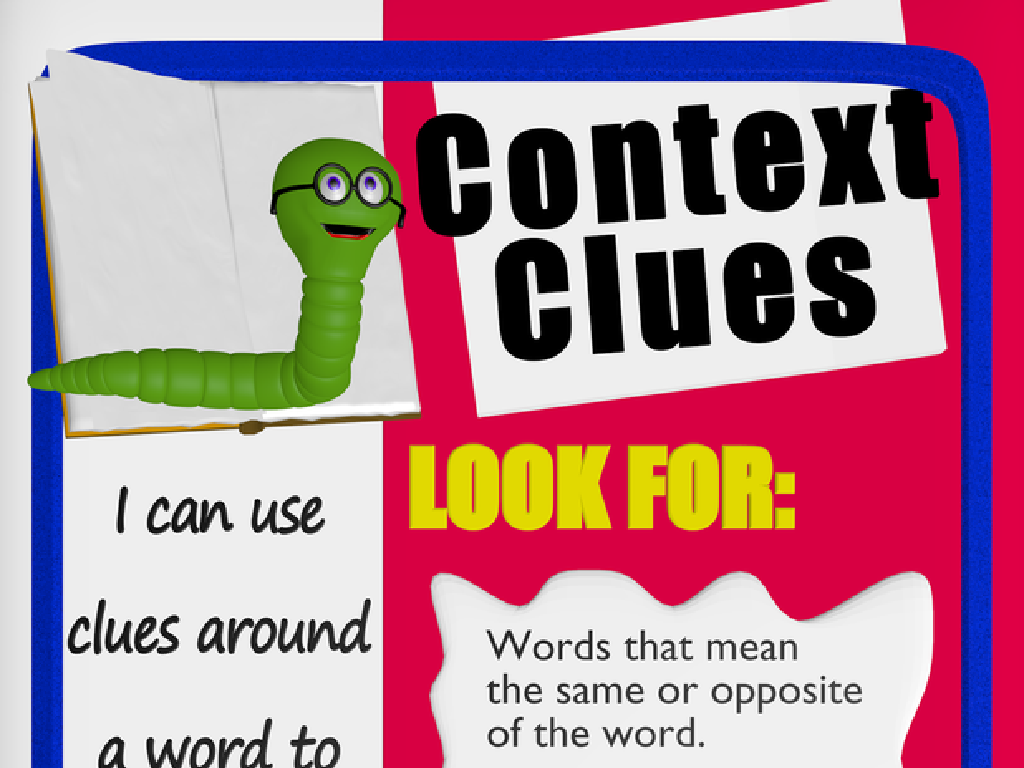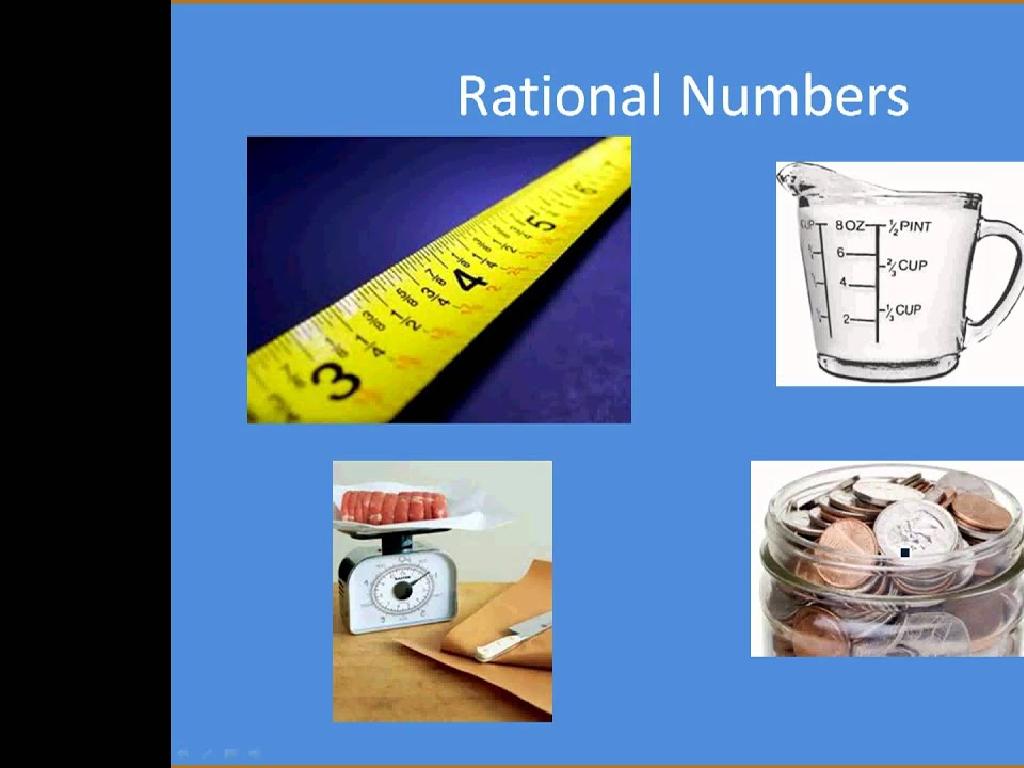Multi-Step Word Problems: Identify Reasonable Answers
Subject: Math
Grade: Fifth grade
Topic: Multi-Step Word Problems
Please LOG IN to download the presentation. Access is available to registered users only.
View More Content
Multi-Step Word Problems: Finding Reasonable Answers
– Understanding multi-step problems
– Problems that require more than one step to solve.
– Importance of step-by-step solving
– Solving step-by-step helps avoid mistakes.
– Today’s goal: Reasonable answers
– Learn to check if an answer makes sense.
– Practice with examples
– Use examples to apply what we learn.
|
This slide introduces students to the concept of multi-step word problems in mathematics, emphasizing the importance of solving these problems in a sequential manner. It’s crucial for students to understand that some problems can’t be solved in one step and may require several operations. By breaking down the problem and tackling each step individually, students can avoid errors and ensure they’re on the right track. Today’s objective is to help students not just find an answer, but to identify whether it’s a reasonable one, given the context of the problem. Encourage students to ask themselves if the answer makes sense and to verify their solutions. Provide practice problems that illustrate common scenarios where students must discern reasonable answers, and discuss strategies for checking their work.
Understanding Multi-Step Word Problems
– Define Multi-Step Word Problems
– Problems requiring more than one step to find the solution.
– Real-life problem examples
– Buying groceries with a budget or planning a party.
– Single vs Multi-Step Problems
– Multi-step involve multiple processes; single-step only one.
– Strategies to solve
– Read carefully, identify steps, solve in order, check work.
|
This slide introduces students to multi-step word problems, which are more complex than single-step problems as they require performing several mathematical operations to reach a solution. Use relatable scenarios like managing a budget while shopping or organizing an event to illustrate how these problems appear in everyday life. Highlight the importance of distinguishing between single-step and multi-step problems, and provide a clear strategy for tackling the latter: careful reading, identifying all the necessary steps, solving each step in sequence, and reviewing the work to ensure the answer is reasonable. Encourage students to practice with examples and to always check their final answer against the question to see if it makes sense.
Key Words in Multi-Step Problems
– Signal words guide operations
– Words like ‘sum’ or ‘altogether’ mean add
– ‘Total’, ‘difference’, ‘product’
– ‘Difference’ means subtract, ‘product’ means multiply
– ‘Quotient’ indicates division
– When you see ‘quotient’, think of how many times one number fits into another
– Practice with example problems
– We’ll solve problems together to identify these words
|
This slide is aimed at helping students recognize key words in word problems that signal specific mathematical operations. Understanding these words is crucial for solving multi-step problems accurately. ‘Total’ often indicates addition, while ‘difference’ suggests subtraction. ‘Product’ and ‘quotient’ are terms for the results of multiplication and division, respectively. During the practice session, present students with several problems and guide them to highlight the key words and discuss the operations they suggest. This will prepare them to tackle more complex problems independently. Encourage students to always look for these words and think about the operations they need to use to find the answer.
Breaking Down Multi-Step Word Problems
– Read the problem carefully
– Understand what the question is asking
– Identify all the steps required
– List out what calculations need to be done
– Work through a sample problem
– Example: If you buy 3 toys at $15 each, how much change from $50?
– Check if the answer is reasonable
|
This slide is aimed at teaching students how to approach multi-step word problems methodically. Start by reading the problem thoroughly to understand what is being asked. Next, identify the different steps needed to solve the problem, such as addition, subtraction, multiplication, or division. Use a relatable example, like purchasing toys with a given amount of money, to illustrate how to break down the problem into manageable steps. After solving, encourage students to review their answers to see if they make sense in the context of the problem. This process helps students to not only find the answer but also to understand the logic behind it, which is crucial for tackling more complex problems in the future.
Solving Multi-Step Word Problems
– Tackle problems one step at a time
– Focus on one part of the problem before moving to the next
– Check your work after each step
– Review calculations to ensure accuracy
– Example: Break down a sample problem
– We’ll use a class example to illustrate the process
– Discuss why each answer is reasonable
– Understand how each step leads to a logical solution
|
This slide is aimed at teaching students the systematic approach to solving multi-step word problems. Emphasize the importance of not rushing through the problem but instead breaking it down into manageable parts. After solving each part, students should check their work to avoid simple mistakes that can lead to incorrect answers. Use a sample problem to demonstrate this process, solving it step by step with the class. This will also be an opportunity to discuss with students how to identify if an answer is reasonable by checking it against the context of the problem. Encourage students to ask themselves if the answer makes sense given the situation described in the problem.
Identifying Reasonable Answers in Word Problems
– Understanding reasonableness
– An answer is reasonable if it makes sense in the context of the problem.
– Using estimation for prediction
– Estimate to get a rough idea of what the answer could be.
– Practice estimation techniques
– Try estimating the result before calculating to save time and check work.
– Estimation vs. exact answers
|
This slide introduces the concept of identifying reasonable answers in multi-step word problems. Emphasize to students that a reasonable answer is one that logically follows from the information given in the problem. Teach them how to use estimation as a tool to predict what an answer might be before solving the problem exactly. This can help them determine if their final answer is in the right ballpark. During practice, guide students through several examples, showing them how to round numbers and perform simplified calculations to estimate. Discuss when an exact answer is needed versus when an estimate is sufficient. Encourage students to always check their work by estimating to see if their exact answer is reasonable.
Avoiding Common Mistakes in Multi-Step Problems
– Remember every step
– Understand the question correctly
– Misreading can lead to wrong answers. Read carefully!
– Always estimate to check answers
– Estimations help verify if the answer is reasonable
– Practice problems for mastery
|
This slide aims to highlight common pitfalls students may encounter while solving multi-step word problems. Emphasize the importance of following each step without skipping any, as missing a step can lead to incorrect answers. Encourage students to read the question multiple times to ensure they understand what is being asked. Estimating the answer before solving can serve as a checkpoint to see if their final answer is in a reasonable range. Provide practice problems that students can work through, which will help them become more familiar with these types of questions and reinforce the strategies to avoid these common mistakes.
Let’s Practice Together: Multi-Step Word Problems
– Group activity: solve a word problem
– Share your solution steps
– Present your final answer
– Discuss the reasonableness of answers
– Does the answer make sense in real life?
|
This slide introduces a class activity focused on solving multi-step word problems. Divide the class into small groups and provide each with a different word problem to solve. Encourage collaboration and discussion within the groups as they work through the problem-solving steps. After solving, each group will share their solution process and the answer they obtained with the rest of the class. Then, lead a discussion on whether the answers are reasonable by considering if they make sense in the context of the problem. For example, if the problem involves combining items, does the number they’ve come up with seem too high or too low? This activity will help students understand the importance of critically evaluating their answers and will enhance their problem-solving skills.
Homework: Mastering Multi-Step Problems
– Practice multi-step problems at home
– Get ready for a mini-quiz on answers
– Continue practicing estimation skills
– Estimation helps check if answers are reasonable
– Understand the importance of reasonableness
– Reasonable answers make sense in real-world context
|
For homework, students should continue to practice solving multi-step word problems to reinforce their understanding and prepare for an upcoming mini-quiz focused on identifying reasonable answers. Emphasize the importance of estimation as a tool to quickly verify the plausibility of their answers. Encourage them to consider if their answers make sense within the context of the problem. Provide additional problem sets for practice and suggest that they work in pairs or groups to discuss their reasoning. The goal is to build confidence in their problem-solving abilities and to help them recognize the practical application of math in everyday situations.
Class Activity: Crafting & Solving Word Problems
– Pair up and write a multi-step problem
– Exchange problems with another pair
– Solve the received problem
– Discuss the solutions’ reasonableness
– Were the answers possible and logical?
|
This activity is designed to engage students in creating and solving their own multi-step word problems, which helps deepen their understanding of mathematical concepts and reasoning. In pairs, students will use their creativity to come up with a word problem that involves multiple steps to solve. After writing their problems, they will trade with another pair to challenge each other. Once the problems are solved, the class will reconvene to discuss the reasonableness of each solution, emphasizing the importance of logical thinking and realistic outcomes in problem-solving. Possible activities could include problems based on real-life scenarios like shopping, cooking, or planning an event. Encourage students to think critically about the steps involved and the plausibility of their answers.






